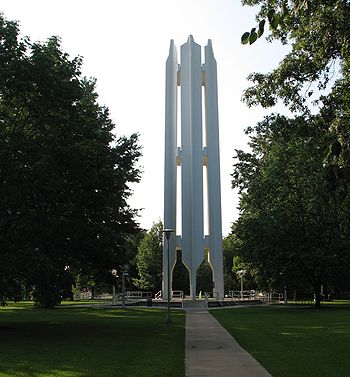
Missouri State Arboretum
Encyclopedia



Northwest Missouri State University
Northwest Missouri State University is a state university in Maryville, Missouri. Founded in 1905 as a teachers college, it offers both undergraduate and graduate programs. The campus, based on the design for Forest Park at the 1904 St. Louis World's Fair, is the official Missouri State Arboretum....
in Maryville, Missouri
Maryville, Missouri
Maryville is a city in Nodaway County, Missouri, United States. The population was 10,581 at the 2000 census. The town, organized on February 14, 1845, was named for Mrs. Mary Graham, wife of Amos Graham, then the county clerk. Mary was the first Caucasian woman to have lived within the boundaries...
and contains more than 111 species of trees.
Northwest has long billed itself as the "most beautiful state university campus" in the state of Missouri thanks to its landscaped tree-lined campus. The campus design was inspired by the Forest Park
Forest Park
-Towns and villages:*Forest Park, Ontario, Canada*Forest Park, Georgia, USA*Forest Park, Illinois, USA*Forest Park, Ohio, Hamilton county, Ohio, USA*Forest Park, Ottawa County, Ohio, USA*Forest Park, Oklahoma, USA...
design for the 1904 St. Louis World's Fair which evolved into the campus for Washington University.
In 1993, the state legislature designated Northwest the official Missouri State Arboretum.
Thomas Gaunt first starting planting trees on the campus when he moved to Maryville in 1857. Gaunt's house has served as the home of all presidents of the university and is on the National Register of Historic Places
National Register of Historic Places
The National Register of Historic Places is the United States government's official list of districts, sites, buildings, structures, and objects deemed worthy of preservation...
. It is in a direct line with the university's landmark Administration Building. The route (called the "Long Walk") was lined with hundreds of trees -- most famously birches (prompting a phrase that the campus was "behind the birches").
Many of the trees date to grounds keeper J. R. Brink, who was known to have planted 300 trees a year starting in 1915. During this period Brink planted a dense forest on practically all land that did not have buildings. The Brink forest has been whittled away with new buildings and memorials.
In the 1960s most of the campus elms were felled by Dutch elm disease
Dutch elm disease
Dutch elm disease is a disease caused by a member of the sac fungi category, affecting elm trees which is spread by the elm bark beetle. Although believed to be originally native to Asia, the disease has been accidentally introduced into America and Europe, where it has devastated native...
. In the 1970s the Bronze birch borer
Bronze birch borer
The bronze birch borer Agrilus anxius is a wood-boring Buprestid beetle native to North America, more numerous in warmer parts of the continent and rare in the north. It is a serious pest on birch trees , frequently killing them...
began killing the birches with the last of the original birches dying in 1997. Johanne Wynne Fairchild in 1979 began a process of cataloging the trees and setting up the trails.
Northwest has enhanced the tree experience by designating three trails through the campus trees:
- The Gaunt Trail - It begins at Hudson Hall and passes more than 39 species
- The Tower Trail - It starts at Roberta Hall and passes more than 32 species
- The Chatauqua Trail - The area by the Ron Houston Center for the Performing Arts just west of Bearcat Stadium. It contains 31 species. It derives its name for the original Maryville Park on the location.

